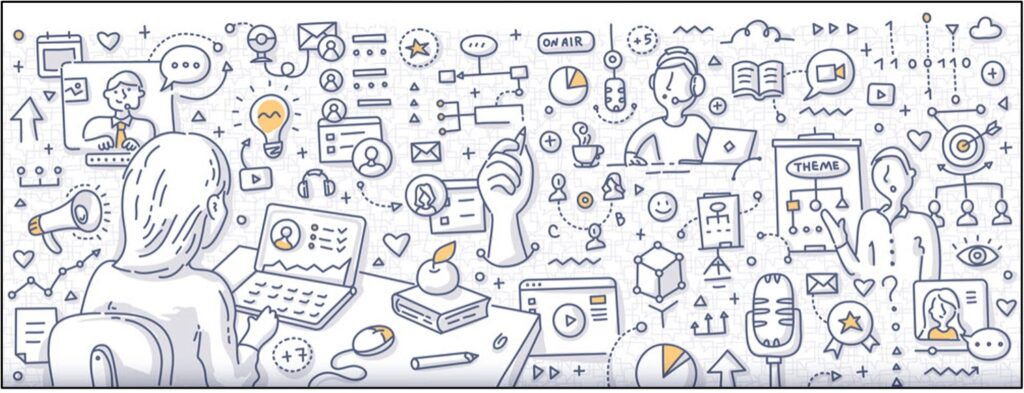What is backchannel communication?
You have been part of a backchannel communication if you have participated in a Twitter feed during a conference presentation or used Zoom chat in a synchronous Zoom session. The term backchannel was first used by Victor Yngve (1970), a professor of linguistics, to describe the concept of two simultaneous communication channels used during a conversation with the backchannel as the secondary mode of communication consisting of verbal and non-verbal cues. Since Yngve’s initial description, the meaning of backchannel communication has evolved to include both synchronous and asynchronous non-verbal communication occurring through a virtual space and allowing participants to engage with each other without interrupting the primary speaker. Ilic (2020) uses the term ‘digital backchannel’ to describe situations where there are “two channels of communication operating simultaneously during collaborative activities” (p. 64).
Benefits of backchannel communication
When students attend class together in a physical space learning can be enhanced by spontaneous conversations that occur before, during, and after class. Integrating digital backchannels into a HyFlex course can replace or supplement these conversations and provide a means of supporting collaboration and communication between remote and in-person participants. Bryce Miller and Baham (2018) suggest that HyFlex classrooms not only stream the lecture but also include a backchannel to support an equivalent communication experience for in-person and remote students.

Below are a few of the benefits of using backchannel communications drawn from Ilic’s (2020) review of the literature. While much of this literature was not specific to HyFlex delivery, these benefits still apply and may be even more apparent in a HyFlex classroom.
Backchannel communication:
- allows students an equal opportunity to process information and provide thoughtful responses, including those who may be hesitant to ask or answer questions in front of the class, and limits the ability of one person to dominate a conversation.
- is a way to support student collaborative learning and increase participation and interactions without disrupting the primary speaker.
- provides students a sense of ownership over learning with a persistent online space that supports anytime, anywhere student-directed discussions.
- leverages social communication and connectivity skills already used by students and allows the near-instantaneous responses they are familiar with.
- supports information transfer by allowing multiple means of expression through a variety of media.

What tools can be used to support digital backchannel communication in HyFlex courses?
The tools used for backchannel communications continue to evolve. Prior to the pandemic, Twitter may have been the most commonly used digital backchannel communication method. With the pivot to online learning and the subsequent explosion in the use of Zoom for synchronous delivery, Zoom chat gained a prominent role in backchannel communications. Before choosing your backchannel communication tool(s), it is important to consider the following:
- which tools are available to you
- faculty and student support available from the company or university
- limitations on use, including any costs that may be incurred
- accessibility to diverse learners
- security or privacy risks
Backchannel tools can be categorized as chat-based including Zoom or other web conferencing software, Microsoft Teams, learning management systems, Slack, Padlet, and many more! Social media platforms such as Twitter are also commonly used for backchannel communication. It is important to note that social media platforms may not be supported by the school or university and it is important to ensure student privacy and security if you require these platforms. Another valuable backchannel can be the use of collaborative notetaking and annotation tools such as Google Docs, Evernote, or Microsoft OneNote.
As you consider which backchannel(s) to use in your course, it is important to plan carefully, consider logistics and communicate expectations to students. We would love to hear how you use backchannel communication in your HyFlex courses!
References
- Bryce Miller, J. and Baham, M.E. (2018). Comparing the HyFlex (hybrid-flexible) model of course delivery in an introductory statistics course and a probability and statistics course for engineers and scientists. In M. A. Sorto, A. White, & L. Guyot (Eds.), Looking back, looking forward. Proceedings of the Tenth International Conference on Teaching Statistics (ICOTS10, July, 2018), Kyoto, Japan. Voorburg, The Netherlands: International Statistical Institute.
- Ilic, P. (2021). Exploring EFL Student Use of Digital Backchannels During Collaborative Learning Activities. JALTCALL2020. DOI: https://doi.org/10.37546/JALTSIG.CALL2020.5
- Yngve, V. (1970). On getting a word in edgeways. Papers from the Sixth Regional Meeting, Chicago Linguistics Society. 567-578. https://ci.nii.ac.jp/naid/10026753338/en/
Thank you for the comprehensive explanation of what is backchannel communication and its benefits! I have participated in HyFlex courses as a grad student and I recognize the benefits mentioned in the post. Adding to these benefits, I think that backchannel communication increases teaching presence as well. When instructors utilize the tools that support backchannel communication appropriately, the interaction between the instructor and the learners is enhanced. Dr. Beatty serves as a good example of that. As a student, I had the opportunity to comprehend the information presented by another colleague better thanks to Dr. Beatty’s critiques and extra resources he provided on Zoom chat during the presentation. With that said, instructors must not forget to record the interaction that takes place on Zoom chat so that the asynchronous learners enjoy the same benefits as well.
Thank you for your feedback Ioanna! You make a very important point- instructors need to be sure to follow the interactions that take place in the backchannel and engage the online participants. Comment on the chat discussions and summarize periodically to engage the two groups with each other and also suggest that the in-person students engage with the backchannel through their devices.
Glori